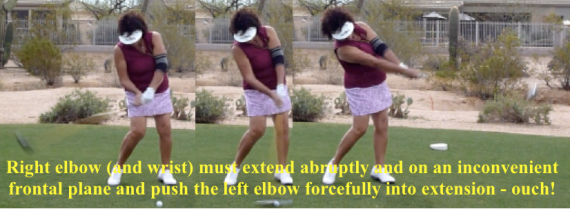Winter Golf Plan – swing vs fitness improvement
The ‘typical’ golf swing requires you to shift weight over the back leg and rotate, and then shift weight to the front leg and rotate. While you do this your spine must not straighten out from its forward bend, nor fall back towards target going back or away from target going through. Your wrists should be able to set an angle and maintain it until impact, and your shaft should be on or slightly under the shaft plane at least from halfway down until impact.
Now if you cannot do all of this, you have fitness/restriction issues and should spend hour upon hour in the gym – or so the folks at TPI and other golf fitness organizations will tell us.
But here are the ACTUAL PROBLEMS:
Suppose you shift a bit too much before starting to turn/rotate? ‘They’ll’ say you swayed! Same move on the downswing – a slide! Wouldn’t you be able to calibrate your backswingshift-and-turn amount more accurately if it was completed during the set-up phase?
If you lift your upper body on the downswing, you’ve ‘early extended’ and apparently 75% of golfers do it! ‘They’ claim it’s because you cannot do a ‘deep overhead squat’ (ie your legs are not strong enough). MGSS says naturally if you tilt your left/lead shoulder going back (which ‘they’ want – dire things can happen if your shoulder plane is shallow), your body HAS to find a way for the trail shoulder to drop down during the downswing, so your spine might have to straighten up! AND, if your right/trail side is lower at address and at impact, why raise it at all and then have to rely on perfect timing to drop it precisely!
AS to the ‘wrist angle’ requirement? It’s just asking for trouble. Why bother with wrist set going back? Do you hit the ball on the backswing? What if the wrists could set NATURALLY, WHEN REQUIRED, during the downswing?
Finally, what is the guarantee that after one became loose in the tight muscles and strong in the weak ones, worked on power and speed, one would be able to deliver the club to the correct spot on the ball at the correct time?
So, it’d be nice if half the visitors to this blog worked on fitness and the other half on making a good MGSS full-swing, and we could compare notes at the beginning of the summer of 2013!
Details of the ‘twelve most common swing faults’ in the new ‘fitness’ section of this blog.





